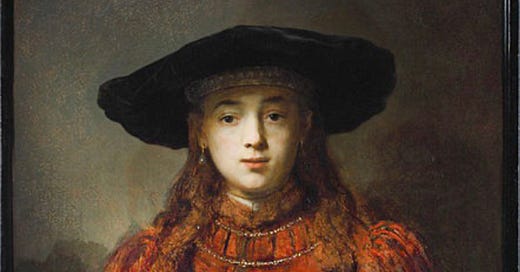I find this image unsettling. And it’s taken me a while to figure out why.
First of all, the girl in question appears to be stepping out of the frame. It’s a so-called Trompe-l'œil, a genre of painting that tricks the eye into thinking that the objects depicted are in fact real. A bit like those 3-D billboards used to promote movies where it looks like the characters are escaping from the screen.
But the picture above doesn’t exactly fit the criteria for a Trompe-l'œil. First of all, the girl isn’t painted to be photorealistic.
Rembrandt knew used thick brushstrokes, and her auburn hair is blurred, blending into her livery. This is not a real person coming out of a realistic background. Rather, it’s like Pygmalion, who carved a woman out of ivory, only for Aphrodite to breathe life into her lifeless form.
In other words, this girl is an automaton, something uncanny, reaching out from beyond the frame, she wants something from us.
Also, there is no realistic background, no context or subtext to who she is or why she’s holding the frame. The backdrop is a hazy blur. And for a moment a shudder runs down my spine. Who is “behind” the frame? Is it me, or her?
Look at how her hands grip the frame and cast a shadow over the fake wood. The German art critic Wolfgang Kempf points out that this is a double illusion. Rembrandt wanted the wood to look like steel; a cold, gleaming surface, not an ornate frame. This is a black box, a portal, not just a frame. The instructions were for it to be hung in the light by an open door, so that one would see it upon entering the house. It’s meant to appear as a crack in reality through which a girl beckons.
And finally, and this is perhaps the most telling detail….notice the girl’s hat. Rembrandt had an obsession with hats, and often depicted himself wearing one so as to shield his eyes. Look closely and you’ll see that even though there is no clear source of light, the girl’s eyes appear ever so slightly shaded by the hat, the better to see us with.
Rembrandt was interested in Trompe-l'œils and painted several of them. But what makes this one stand out is that it blurs the lines between an optical illusion and a meditation on the art of subjectivity itself.
Instead of using the 3D effect to entertain or titillate, he breaks the fourth wall in a manner that questions the very nature of reality itself. If art -as Plato famously argues- is a copy of a copy, then who is the original? Us, or her?
The philosopher Descartes, a contemporary of Rembrandt, argued that illusions were a vital component of all subjectivity. After all, when we “see through” an illusion, we remind ourselves that we exist. But in this painting it’s the girl, looking at us, who seems to remind herself that she exists. We are caught in each others gaze, and she seems to know something we don’t. No wonder it was compared to the Mona Lisa by Rembrandt’s contemporaries. There’s a knowing smile, some secret being kept from us. We are no longer the spectator, but the observed.
Julian
Thanks for reading this newsletter. If you’d like to access a weekly bonus audio download, please consider becoming a $5 subscriber. It’s very much appreciated and helps me keep posting these open-access art introductions. You can sign up below, thank you!





This is a very striking and moving painting. 1641 Titus was born, Saskia’s and his last child, all three others had died only weeks after being born years earlier. Saskia never recovered from the birth and died 1642 most likely of tuberculosis.
Perhaps he was haunted by losses and the girl seems to have a likeness with her. Perhaps an almost magical image of youth, stepping forever between him and the canvas from wich she seems to beckon.Titus too would die young 1668 and Rembrandt survived alone only one more year and died impoverished. He was buried in an unmarked grave.